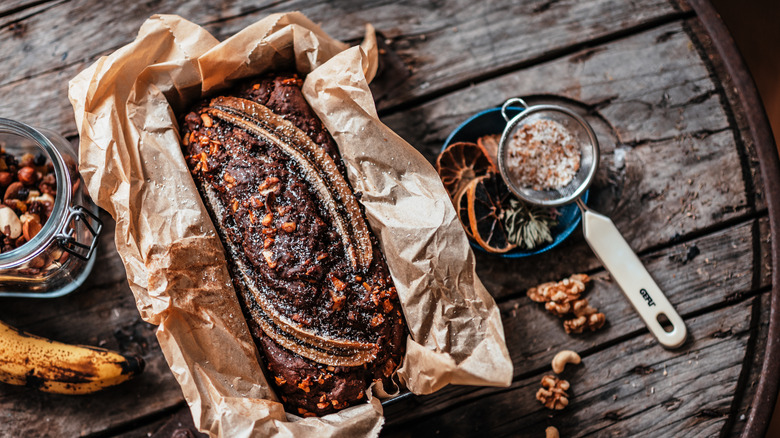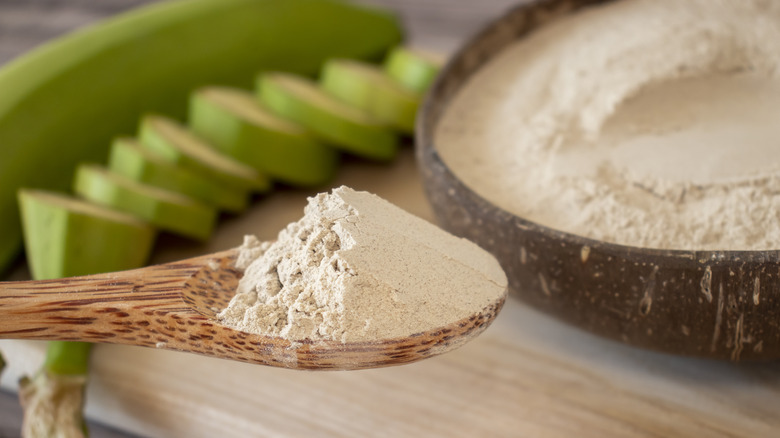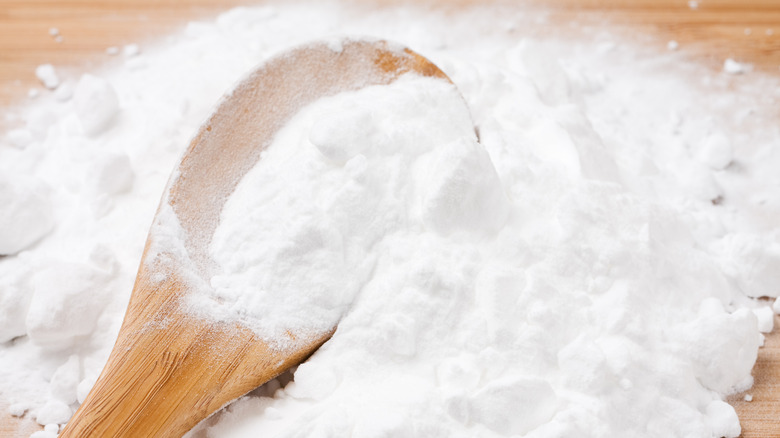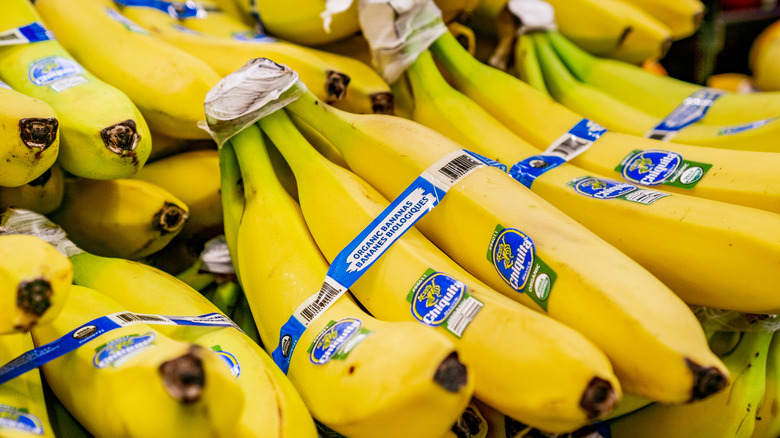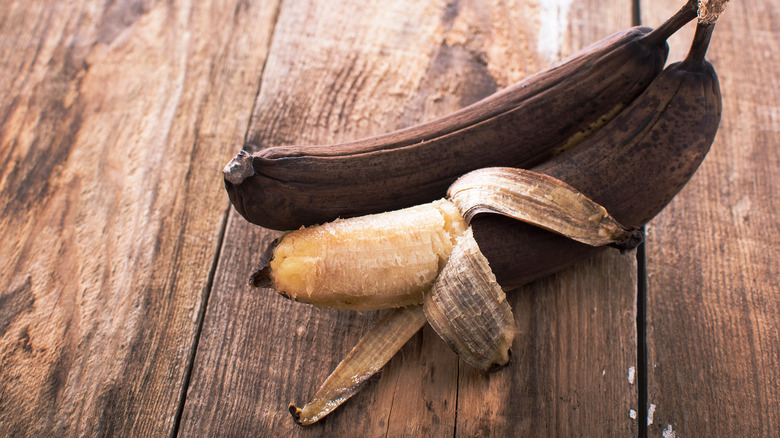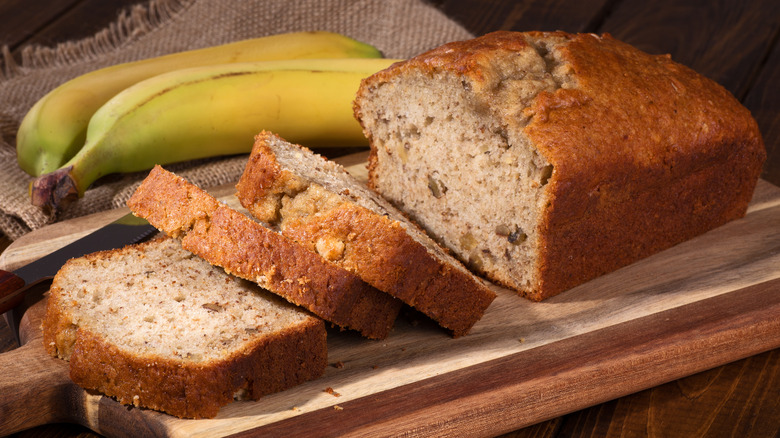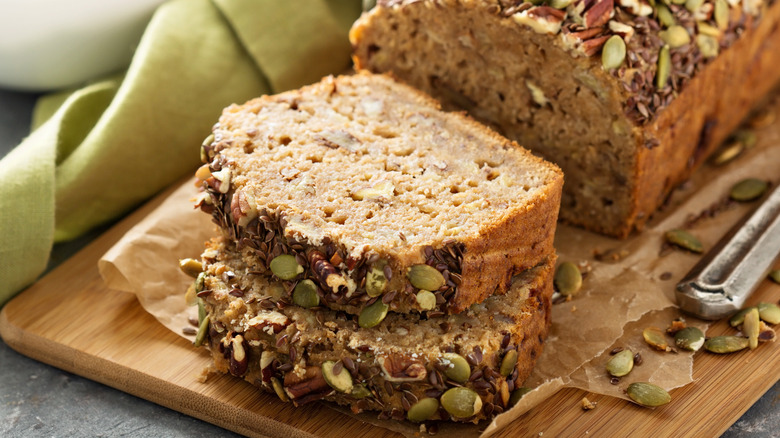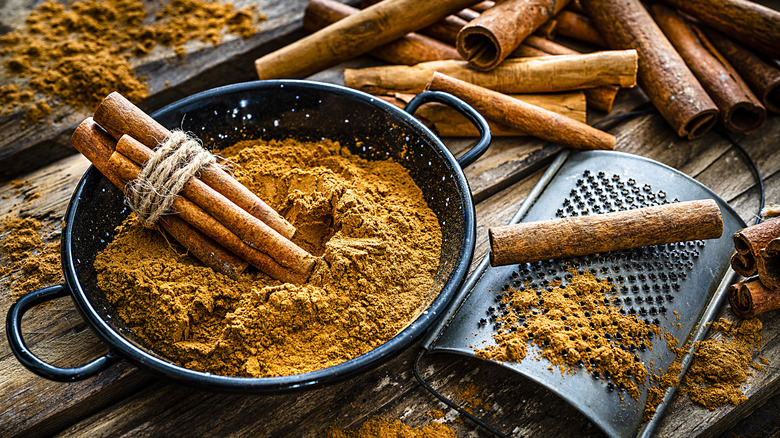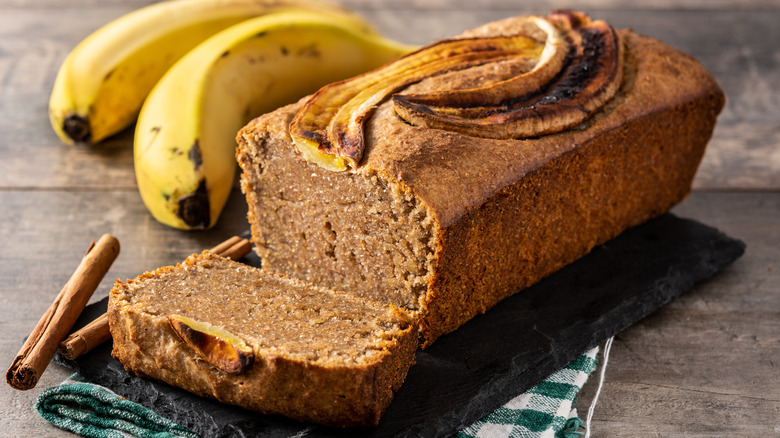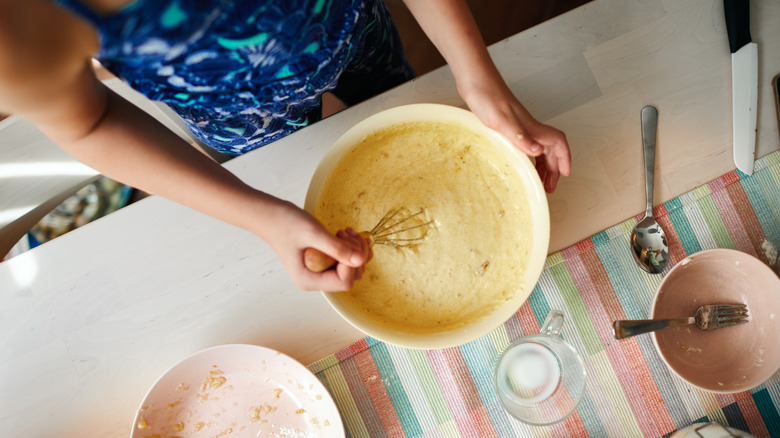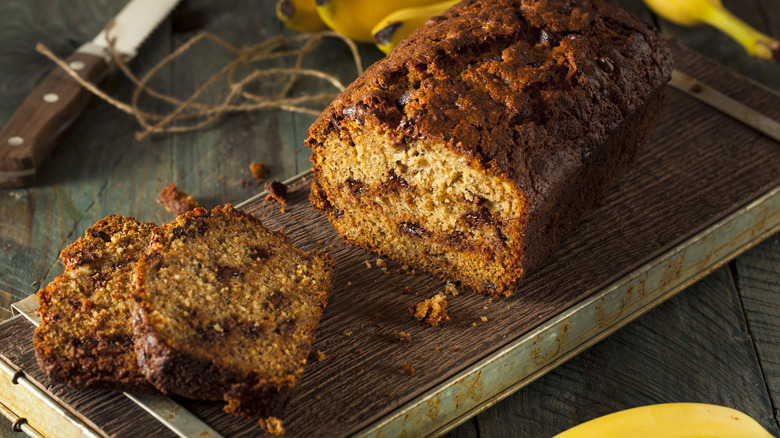The History Behind Banana Bread
Banana bread is a comfort food favorite for good reason. Moist, flavorful, and just sweet enough, it's a quick and easy way to use up bananas that are slightly past their prime. But banana bread has not always boasted the same spot in the American culinary consciousness.
Before we dig into banana bread history, however, a word on nomenclature. After all, calling banana bread a "bread" is a bit of the order of wishful thinking, given the texture and sugar content more reminiscent of a cake (something to which Great British Bake Off host Paul Hollywood attests). This may be down to historic precedent; after all, early banana bread recipes were far more savory. And while these days most recipes call for enough sugar, spice, and fat to make banana bread far more cake-adjacent, calling it bread certainly makes us feel better about having a slice of it for breakfast or as an afternoon treat.
Early versions are different from the banana bread we love today
Banana bread these days is usually made with a combination of mashed banana, egg, flour, sugar, spices, and some sort of chemical leavening agent, like baking powder, baking soda, or both. But earlier versions of banana bread popular at the turn of the century saw the namesake fruit integrated, not in its raw form, but rather as flour.
The banana flour at the heart of these early recipes banana breads began with green bananas, which were dried and pulverized. The resulting loaf was a bit more similar to a regular loaf of bread, albeit sans gluten, and was far less sweet than the banana bread we know and love today. It was particularly popular in the Caribbean, where banana flour is still a popular, affordable staple. Elsewhere, gluten-free banana flour has conquered the hearts and kitchens of paleo bakers thanks to its richness in three different types of fiber and loads of minerals.
Banana bread couldn't have been made without baking powder
Using chemical leavening agents as opposed to yeast to help baked goods rise is "an American invention," food historian Linda Civitello told CNN. While early such leaveners like pearlash and potash, both of which are alkaline salts, became popular in the 18th and 19th centuries — and while baking powder as we know it today (albeit with the name yeast powder) was invented in 1856 by a Harvard chemistry professor — such ingredients didn't really become commercially available until the beginning of the 1900s, when companies like Royal, Calumet, and Clabber Girl began marketing baking powder in different forms.
The widespread availability of baking powder paved the way for the development of a whole new category of baked goods: quick breads. These one-bowl recipes encompass American staples like zucchini bread, pumpkin loaf, and, of course, banana bread, quickly rising to popularity thanks to their ease as compared to traditional breads, which rely on yeast to rise and thus take a far longer time to prepare.
Banana bread's origin starts with the arrival of bananas in the U.S.
While quick breads were on the rise in the U.S. as early as the 19th century, banana bread specifically was nowhere to be found. Bananas, after all, had yet to become ubiquitous stateside, in large part due to their propensity for quickly ripening and rotting onboard transport ships.
It wasn't until the early 20th century that the United Fruit Company — later known as Chiquita Banana — mastered the art of refrigerated transport and thus began importing shipments of bananas to the U.S. Soon, bananas were well on their way to becoming a staple in American kitchens. But at this point, bananas were more often used as a garnish for desserts than as a main ingredient in baked goods like banana bread. It would take another few decades for the American classic quick bread to embrace this new, exotic fruit.
The Great Depression helped banana bread become a household staple
It would take the Wall Street crash and subsequent economic depression for banana bread as we know it to come to fruition. Following the crash, many households were stretching very small budgets just to make ends meet, and a no-waste mindset understandably became quite popular in many American households. Seeing as this belt-tightening coincided with the ubiquitousness of both bananas and baking powder in American kitchens, the time was ripe for banana bread to be born.
Slightly overripe bananas weren't that appealing on their own, but when mashed in with wheat bran and incorporated into a quick bread recipe, they become the ideal stand-in for more expensive sugar. While certainly less rich and lower in fat than the banana bread recipes we know and love today, these early iterations of banana bread would have been a real treat in times of such austerity.
One of the first banana bread recipes was published in 1933 by Pillsbury
It's tough to know for sure when and how the first banana bread recipes came to be. Some claim that it was frugal housewives who came up with the idea; others credit corporate kitchens with the invention, which some sources say may have been a means of encouraging folks to cut down on food waste (and boast the nutritional profile of their home bakes). Whoever came up with the idea, the early 30s saw a multitude of recipes for banana bread published by the likes of Better Homes and Gardens, the United Fruit Company, and the Pillsbury Flour Mills Company. It's this latter recipe, which appeared in a cookbook entitled "Balanced Recipes" that's most often credited as being the first.
This recipe saw mashed bananas combined with sour cream, shortening, a touch of sugar, both flour and wheat bran, and chopped nutmeats, as well as two kinds of chemical leavening and a touch of salt. Like many other banana bread recipes of the time, it was heavier on the bran and lighter on the fat, with a far more pronounced banana flavor than in many modern iterations.
Banana bread recipes have evolved over time
Banana bread recipes have evolved to reflect the trends of the times, and one major change occurred in the '40s when World War II saw certain staples rationed like eggs and butter. The 1946 edition of "The Joy of Cooking" features a banana bread recipe that boasts no egg and no spices; it also relies on sour cream and buttermilk, which were less expensive and easier to find than whole milk at the time. The resulting loaf has a finer texture than the one popular in the '30s, thanks to the use of flour rather than bran.
But the '40s weren't the only decade that had an effect on banana bread. Moving into the 60s, a desire for healthier, more rustic bakes that relied less on refined ingredients saw banana bread recipes that capitalized on the richer flavors of whole wheat flour and brown sugar to make a more nutrient-dense version of the quick bread.
Banana bread hasn't always been spiced
Most banana bread recipes these days at least include cinnamon, if not other warm baking spices like nutmeg or ginger, which play wonderfully with the subtle sweetness of bananas. But earlier recipes were far simpler and more muted in flavor, a trend that persisted well through the 60s.
In the latter decades of the 20th century, however, bakers began to embrace flavorful spices in their banana bread recipes. In 1972, Ithaca, NY's Moosewood Restaurant published a banana loaf recipe absolutely bursting with flavor, scented as it was with vanilla, nutmeg, and coffee, not to mention sesame seeds, orange, and almond. In the 90s, meanwhile, King Arthur Flour's "The Baking Sheet" newsletter featured a loaf spiced with both cinnamon and nutmeg. Today, recipes even take inspiration from Indian chai in their spice blends, which may feature cardamom, ginger, and more spices. While not all banana bread recipes today feature spices, it's way more widespread than it once was.
Banana bread has long been perceived as a health food
While early versions of banana bread, like the ones made with banana flour or loads of bran, may well have been healthier alternatives, make no mistake: Most modern banana breads are far from what's now considered health food. Healthline is quite clear in categorizing banana bread as a dessert that is high in carbs, added sugar, and fat. While you can certainly change up your recipes to lower added sugars and fats, and up the health benefits with the addition, for example, of antioxidant cinnamon, it still remains a dessert.
But health doesn't begin and end with calories. Indeed, homemade banana bread — and the act of baking in general — can help manage stress and teach mindfulness, according to Julie Ohana, a licensed master social worker and the founder of Culinary Art Therapy in West Bloomfield, Michigan. "There's a psychological term called 'cadence,'" she told CNN. "When you do something over and over again, it creates stability and feelings of comfort ... it soothes our minds and our bodies."
Banana bread became ultra popular during the pandemic
It's in large part thanks to the mental health benefits of baking, experts say, that homemade banana bread soared to such popularity during the pandemic. Indeed, alongside sourdough, banana bread became a pet project of sorts during the lockdown era, with Google searches for banana bread going up 54 percent around the world by early April 2020, and celebrities from Chrissy Teigen and the cast of Derry Girls offering up their own recipes, many of which featured a sliced banana half on top.
"'In uncertain times, many will try and establish some kind of control to cope," Counsellor and psychotherapist Katerina Georgiou told Grazia, at the time of the trend. "Food is a common aspect of our lives we take control from." That banana bread would be the recipe so many chose didn't surprise Ohana. "It strikes a chord with everybody," she told CNN at the time. "It's joy and comfort and familiarity." These values became particularly sought after, given the uncertainty of the pandemic. "We're all looking for ways to make ourselves feel better and make ourselves feel comforted," she added. Baking banana bread was certainly one of them.
There are many versions of banana bread
Like many other simple bakes, banana bread is a bit of a blank canvas that creative bakers can play with. Different recipes may see banana bread gilded with chocolate chips, pineapple, raspberries, or macadamia nuts for even more flavor and texture. Or for a surprising marriage of savory and sweet evoking Elvis' favorite sandwich, you can fold in peanut butter and bacon.
And add-ins aren't the only way you can toy with the classic. Some iterations of banana bread lean even harder into the dessert category by marbling the batter with chocolate or cookie butter, while others gild the lily (and totally transform banana bread into a true cake) by frosting it with cream cheese frosting. In other countries, banana bread deviates even more from the quick bread we know and love. In Vietnam, for instance, banana bread is less of a quick bread and more of a bread pudding, while in the Philippines, the cake is studded with chocolate and steamed rather than baked for a totally unique texture.
